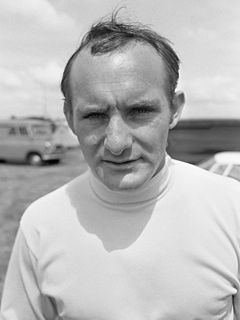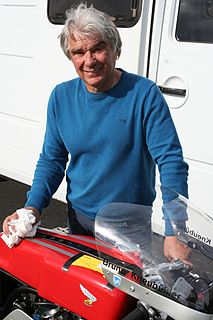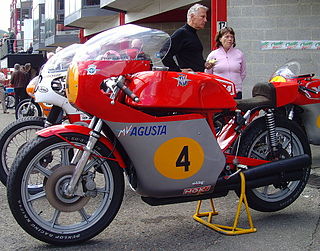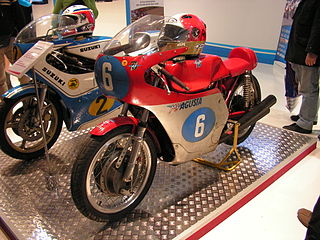| Bo Granath | |||||||||||||||||||||||||||||
|---|---|---|---|---|---|---|---|---|---|---|---|---|---|---|---|---|---|---|---|---|---|---|---|---|---|---|---|---|---|
 | |||||||||||||||||||||||||||||
| Nationality | | ||||||||||||||||||||||||||||
| |||||||||||||||||||||||||||||
Bosse "Bo" Granath is a Swedish former Grand Prix motorcycle road racer. His most successful competitive year was 1972, when he finished fifth in the 500cc world championship riding a Husqvarna motorcycle. [1]
| Bo Granath | |||||||||||||||||||||||||||||
|---|---|---|---|---|---|---|---|---|---|---|---|---|---|---|---|---|---|---|---|---|---|---|---|---|---|---|---|---|---|
 | |||||||||||||||||||||||||||||
| Nationality | | ||||||||||||||||||||||||||||
| |||||||||||||||||||||||||||||
Bosse "Bo" Granath is a Swedish former Grand Prix motorcycle road racer. His most successful competitive year was 1972, when he finished fifth in the 500cc world championship riding a Husqvarna motorcycle. [1]
Bo Granath drove his first national race in 1960. In the winter, while doing military service, he bought a 500cc Norton 30M (Manx) for the 1961 season. He had a junior license, but because there were so few junior drivers the seniors ride along. In Karlskoga he immediately became fourth behind three senior drivers, but with a lap behind. He also bought a 350cc Norton 40M for the second Swedish champion race. In Falkenberg, he finished fourth in both classes. In the Swedish championship, he was fifth in both classes. He applied for an international license to be allowed to start in the Grand Prix of Sweden. [2]
1962 was a school year for Granath, with a lot of bad luck and poor results, but thanks to his international license he was able to start in many foreign races. He rode a number of international races in Belgium and the Netherlands, the Ulster Grand Prix and the GP of East Germany, but his best result was 13th place on the Sachsenring. [3]
In 1963 he bought a 350cc AJS 7R and a 500cc Matchless G50. These machines were found to be fast and reliable. He went to Britain to ride at Silverstone, Snetterton and Oulton Park and was impressed by the speeds in the British races. In Oulton Park, some riders drove him on three laps, but he learned a lot and in August he went to Oulton again. In the meantime, he had also driven the TT van Man for the first time. He experienced a perilous moment when a gas line broke at the Highlander. The gasoline came on the open primary chainrightly, caught fire and the front of the AJS caught fire. Granath looked at a wall of fire but did not dare to jump off his engine at about 180 km/hour. He slid over the back of his saddle, set his feet on the road, and steered the machine by holding the saddle until he dared to drop. The AJS crashed into a wall at Glen Helen. Granath sustained severe burns on an arm and foot and had to recover for a long time. [4]
In 1964 he won his first race, the 500cc race in Falkenberg, but he crashed hard in Oulton Park and got fear of still racing. As a result, he performed poorly throughout the season and his anxiety persisted until mid-1965. Only after the Man's TT did his fears disappear, strangely enough, because he had learned to drive with two wheels in Man. He now had an MZ RE 125 in addition to the AJS and the Matchless. In 1965 he managed to win his first Swedish championship titles: in the 125cc and 500cc classes. In 1966 he again became Swedish 125cc champion. [5]
In 1967 he had a very good season. He became Swedish champion in three classes and scored his first World Championship points in the Grand Prix road race of Finland when he finished fourth in the pouring rain in the 500cc class. He was almost third but got problems with his clutch so he had to let Billie Nelson pass. Two days before this race, Bo Granath's first son Peter was born. Earlier in the season, he had finished seventh in the - also wet - Belgian Grand Prix, but in that time only the first six finishers received points. In this season he also started Husqvarna 's for the first time: in the 250cc class and the 350cc class came out with single-cylinders from the Swedish brand. The frames were built by Bertil Persson. He won almost all Swedish races with the 350cc machine. [6]
In 1968 he asked the Husqvarna engineer Ruben Helmin to build a 500cc two-cylinder. This machine was ready by the end of the season and Granath won the last two Swedish races. He became Swedish champion in the 350cc class.
In 1969, Granath rode a fairly full GP season. For the 125cc race in the French GP, he even got a YZ 623 prototype from Yamaha, with which he managed to take the lead in the race until he failed with a broken crankshaft. His air-cooled Husqvarna 500 two-cylinder engine was still very unreliable and he only scored four World Championship points this year thanks to his seventh place in the 125cc Grand Prix of Belgium. [7]
For the 1970 season, Bo Granath purchased two Yamahas for the 250 and 350cc classes. In his first 250cc race in France, he immediately became sixth, but also second Yamaha driver behind factory driver Rodney Gould. He finished the season with a ninth place in the 250cc class. The Husqvarna was still not reliable, but it did bring him the Swedish title in the 500cc class. [8]
The opening race of the 1971 season, the Austrian GP, went very well, with a fifth place in the 350cc class and a sixth place in the 250cc class. Granath finished seventh in the 350cc class. Also in the 500cc class, it went better now that the Husqvarna remained intact a little more often: he became 15th. It was the season in which the 500cc two-stroke engines became stronger, but it was Kawasaki H 1 500 Mach IIIs and Suzuki T 500s that set the tone. Giacomo Agostini was still supreme with his MV Agusta 500 3C. Granath scored the first World Championship points for Husqvarna in the 500cc class during theTT van Assen, in which he finished eighth behind.
A new 500cc engine appeared in 1972: drivers discovered that a lightly drilled Yamaha TR 3 was a good weapon to beat the 500cc machines due to its manoeuvrability and low weight. After the two Agustini and Alberto Pagani MV Agustas, Bruno Kneubühler and Rodney Gould took third and fourth place in the championship with these machines. However, the Huqvarna from Bo Granath was now very reliable. He even had to cross away from a few results and became fifth in the world championship. In the GP of Austria and the GP of Sweden, he achieved his only podium places. [9]
With the arrival of the factory Yamaha TZ 500 and the König by Kim Newcombe, it was difficult in 1973 to score points in the 500cc class. Granath also often dropped out and scored only 12 points.
In 1974, the Husqvarna was definitely no longer fast enough to score points. Granath only dropped out once but remained scoreless. From that moment he started driving fewer and fewer GPs. Remarkably, he started in three classes in 1975 in the TT van Man, a race that in the meantime was boycotted by almost everyone because of the dangerous circuit. In the 1976 season, Bo Granath scored his last World Cup points: he finished ninth in the 350cc GP of Yugoslavia. In 1977 he became Swedish champion in the 750cc class. [10]

Barry Steven Frank Sheene was a British professional motorcycle racer. He competed in Grand Prix motorcycle racing and was a two-time world champion, winning consecutive 500cc titles in 1976 and 1977.

Stanley Michael Bailey Hailwood, was a British professional motorcycle racer and racing driver. He is regarded by many as one of the greatest racers of all time. He competed in the Grand Prix motorcycle world championships from 1958 to 1967 and in Formula One between 1963 and 1974. Hailwood was known as "Mike The Bike" because of his natural riding ability on motorcycles with a range of engine capacities.

Johnny Alberto Cecotto Persello, better known as Johnny Cecotto, is a Venezuelan former professional Grand Prix motorcycle racer and auto racer. He rose to prominence as a teenage prodigy in 1975 when he became the youngest motorcycle road racing world champion at the age of 19. Despite the auspicious beginning to his motorcycle racing career, he suffered numerous injuries and mechanical problems which curtailed his success in motorcycle Grand Prix racing.
Jarno Karl Keimo Saarinen was a Finnish professional Grand Prix motorcycle road racer. In the early 1970s, he was considered one of the most promising and talented motorcycle racers of his era until he was killed during the 1973 Nations Grand Prix in Italy. Saarinen's death led to increased demands for better safety conditions for motorcycle racers competing in the world championships. He remains the only Finn to have won a motorcycle road racing world championship. Saarinen was inducted into the F.I.M. MotoGP Hall of Fame in 2009.
The 1967 Grand Prix motorcycle racing season was the 19th F.I.M. Road Racing World Championship Grand Prix season. The season consisted of thirteen Grand Prix races in six classes: 500cc, 350cc, 250cc, 125cc, 50cc and Sidecars 500cc. It began on 30 April, with Spanish Grand Prix and ended with Japanese Grand Prix on 15 October.

Phillip William Read, is an English former professional motorcycle racer. He competed in Grand Prix motorcycle racing from 1961 to 1976. Read is notable for being the first competitor to win world championships in the 125 cc, 250 cc and 500 cc classes. Although he was often overshadowed by his contemporary, Mike Hailwood, he won seven FIM Grand Prix road racing world championships. In 2013, Read was named an FIM Legend for his motorcycling achievements.

Ron Haslam is an English former Grand Prix motorcycle road racer who had been racing for over thirty years, winning three World titles, four British championships and having ridden in almost 110 GPs. Haslam spends much of his time helping his son Leon Haslam in his racing career and training riders and racers alike at his Race School based at Donington racetrack, Leicestershire.

Carlos Alberto Lavado Jones is a Venezuelan former professional Grand Prix motorcycle racer. He competed in the FIM motorcycle Grand Prix world championships from 1978 to 1992. Lavado is notable for winning two 250cc road racing world championships in 1983 and 1986. He joins Johnny Cecotto as the only two Venezuelans to win Grand Prix World Championships.
Robert Leslie Graham was a British motorcycle road racer who competed in the 1930s and 1940s. He won the inaugural Grand Prix motorcycle racing 500 cc World Championship in 1949.

The 1980 Grand Prix motorcycle racing season was the 32nd F.I.M. Road Racing World Championship season.

The 1970 Grand Prix motorcycle racing season was the 22nd F.I.M. Road Racing World Championship Grand Prix season. The season consisted of twelve Grand Prix races in six classes: 500cc, 350cc, 250cc, 125cc, 50cc and Sidecars 500cc. It began on 3 May, with West German Grand Prix and ended with Spanish Grand Prix on 27 September.
Robert MacGregor McIntyre was a Scottish motorcycle racer. The first rider to achieve an average speed of 100 mph (160 km/h) for one lap of the Snaefell Mountain Course in 1957, McIntyre is also remembered for his five motorcycle Grand Prix wins which included three wins at the Isle of Man TT races, and four victories in the North West 200. He died nine days after injuries sustained racing at Oulton Park, Cheshire, England in August 1962.

Anton "Toni" Mang is a former five-time world champion in Grand Prix motorcycle racing from Germany.

Bruno Kneubühler is a Swiss former professional Grand Prix motorcycle road racer.
The 2002 Grand Prix motorcycle racing season was the 54th Fédération Internationale de Motocyclisme (FIM) Road Racing World Championship season. The season consist of 16 races, which started with the Japanese Grand Prix on 7 April and ended with the Valencian Community Grand Prix on 3 November.

Hideo Kanaya was a Japanese professional motorcycle racer and motorcycle racing team manager. He competed in the Grand Prix motorcycle road racing world championships from 1967 to 1975. He dominated Japanese road racing in the early 1970s and was the first Japanese rider to win a world championship 500cc Grand Prix race. Although Kanaya was a competitive racer, he was never allowed to compete in a full season in the world championships as, his main responsibility was as a test rider in Japan.
Ralph B. Rensen was an English Grand Prix motorcycle road racer.
Jimmy H. Simpson (1898–1981) was a British motorcycle racer.

The MV Agusta 500cc road racers were motorcycles that the manufacturer MV Agusta built and which were used to compete in 500cc Grand Prix motorcycle racing series between 1950 and 1976. 18 500cc world championship titles were achieved with these machines ridden by John Surtees, Gary Hocking, Mike Hailwood, Giacomo Agostini and Phil Read between 1958 and 1974.

The MV Agusta 350 cc racers were motorcycles produced by MV Agusta between 1954 and 1976 and raced in the 350 cc motorcycle GP championships. 10 world titles were achieved by riders John Surtees, Gary Hocking and Giacomo Agostini on these machines.